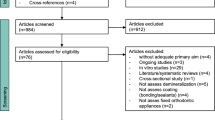Abstract
Objective
To compare the effectiveness of hydrophilic resin-based versus hydrophobic resin-based and glass-ionomer pit and fissure sealants.
Methods
The review was registered with Joanna Briggs Institute and followed PRISMA (Preferred Reporting Items for Systematic Reviews and Meta-Analyses) guidelines. PubMed, Google Scholar, Virtual Health Library, and Cochrane Central Register of Controlled Trials were searched from 2009–2019 using appropriate keywords. We included randomized controlled trials and randomized split-mouth trials conducted among 6–13-year-old children. The quality of included trials was assessed using modified Jadad criteria and risk of bias using guidelines specified by Cochrane. GRADE (Grading of Recommendations Assessment, Development, and Evaluation) guidelines were used to assess the overall quality of studies. We used the random-effects model for meta-analysis. Relative risk (RR) and confidence intervals (CI) were calculated & heterogeneity was tested using I² statistic.
Results
Six randomized clinical trials and five split-mouth trials met the inclusion criteria. The outlier augmenting the heterogeneity was omitted. Based on very-low to low-quality evidence, loss of hydrophilic resin-based sealants was less likely as compared to glass-ionomer fissure sealants (4 trials at 6 months; RR = 0.59; CI = 0.40–0.86), while it was similar or slightly lower than hydrophobic resin-based sealants (6 trials at 6 months; RR = 0.96; CI = 0.89–1.03); (6 trials at 12 months; RR = 0.79; CI = 0.70–0.89); (2 trials at 18 months; RR = 0.77; CI = 0.48–0.25).
Conclusion
This study revealed that retention of hydrophilic resin-based sealants is better than glass ionomer sealants but similar to hydrophobic resin-based sealants. However, higher-quality evidence is necessary to underpin the outcomes.
This is a preview of subscription content, access via your institution
Access options
Subscribe to this journal
Receive 4 print issues and online access
$259.00 per year
only $64.75 per issue
Buy this article
- Purchase on Springer Link
- Instant access to full article PDF
Prices may be subject to local taxes which are calculated during checkout




Similar content being viewed by others
References
Mohanraj M, Prabhu R, Thomas E, Kumar S. Comparative evaluation of hydrophobic and hydrophilic resin-based sealants: a clinical study. J Contemp Dent Pract. 2019;20:812–7.
Haricharan PB, Barad N, Patil CR, Voruganti S, Mudrakola DP, Turagam N. Dawn of a new age fissure sealant? A study evaluating the clinical performance of embrace WetBond and ART sealants: results from a randomized controlled clinical trial. Eur J Dent. 2019;13:503–9.
Ahovuo-Saloranta A, Forss H, Walsh T, Nordblad A, Mäkelä M, Worthington HV. Pit and fissure sealants for preventing dental decay in permanent teeth. Cochrane Database Syst Rev. 2017;7:CD001830.
Correr GM, Caldo-Teixeira AS, Alonso RCB, Puppin-Rontani RM, Sinhoreti MAC, Correr-Sobrinho L. Effect of saliva contamination and re-etching time on the shear bond strength of a pit and fissure sealant. J Appl Oral Sci. 2004;12:200–4.
Askarizadeh N, Norouzi N, Nemati S. The effect of bonding agents on the microleakage of sealant following contamination with saliva. J Indian Soc Pedod Prev Dent. 2008;26:64–6.
Mickenautsch S, Yengopal V. Caries-preventive effect of glass ionomer and resin-based fissure sealants on permanent teeth: an update of systematic review evidence. BMC Res Notes [Internet]. 2011;4:22. http://www.biomedcentral.com/1756-0500/4/22.
Alirezaei M, Bagherian A, Sarraf Shirazi A. Glass ionomer cements as fissure sealing materials: yes or no?: A systematic review and meta-analysis. J Am Dent Assoc [Internet]. 2018;149:640–9.e9. https://doi.org/10.1016/j.adaj.2018.02.001.
Maserejian NN, Trachtenberg FL, Wheaton OB, Calafat AM, Ranganathan G, Kim HY, et al. Changes in urinary bisphenol A concentrations associated with placement of dental composite restorations in children and adolescents. J Am Dent Assoc [Internet]. 2016;147:620–30. https://doi.org/10.1016/j.adaj.2016.02.020.
Fleisch AF, Sheffield PE, Chinn C, Edelstein BL, Landrigan PJ. Bisphenol A and related compounds in dental materials. Pediatrics. 2010;126:760–8.
Ford C. Dental Sealant Available Without Bisphenol A (BPA). 2010 Sep; Available from: https://www.prweb.com/releases/2010/09/prweb4499164.htm
Askarizadeh N, Heshmat H, Zangeneh N. One-Year Clinical Success of Embrace Hydrophilic and Helioseal-F Hydrophobic Sealants in Permanent First Molars: A Clinical Trial. J Dent (Tehran) [Internet]. 2017;14:92–9. Available from: http://www.ncbi.nlm.nih.gov/pubmed/29104600%0A, http://www.pubmedcentral.nih.gov/articlerender.fcgi?artid=PMC5662514
Schünemann H. GRADE Handbook. 2015;5:1–57.
Alsabek L, Al-Nerabieah Z, Bshara N, Comisi JC. Retention and remineralization effect of moisture tolerant resin-based sealant and glass ionomer sealant on non-cavitated pit and fissure caries: randomized controlled clinical trial. J Dent [Internet]. 2019;86:69–74. https://doi.org/10.1016/j.jdent.2019.05.027.
Konde S, Raj S, Kumar N, Bhat P. Moisture-tolerant resin-based sealant: a boon. Contemp Clin Dent. 2013;4:343.
Ratnaditya A, Kumar MGM, Jogendra SSA, Zabirunnisa M, Kandregula CR, Kopuri RKC. Clinical evaluation of retention in hydrophobic and hydrophillic pit and fissure sealants-a two year follow-up study. J Young Pharm. 2015;7:171–9.
Schlueter N, Klimek J, Ganss C. Efficacy of a moisture-tolerant material for fissure sealing: a prospective randomised clinical trial. Clin Oral Investig. 2013;17:711–6.
Topal BG, Kirzioglu Z. Evaluation of the fissure sealants applied to erupting permanent molars in accordance to eruption stages: a prospective study. Niger J Clin Pract. 2019;22:1495–502.
Khatri SG, Samuel SR, Acharya S, Patil S, Madan K. Retention of Moisture-tolerant and Conventional Resin-based Sealant in Six- to Nine-year-old Children. Pediatr Dent. 2015;37:366–70.
Subramaniam P, Jayasurya S, Babu KLG. Evaluation of glass carbomer sealant and a moisture tolerant resin sealant – a comparative study. Int J Dent Sci Res [Internet]. 2015;2:41–8. https://doi.org/10.1016/j.ijdsr.2015.05.001.
Bhatia MR, Patel AR, Shirol DD. Evaluation of two resin based fissure sealants: a comparative clinical study. J Indian Soc Pedod Prev Dent. 2019;30:1–5.
Messer LB, Calache H, Morgan MV. The retention of pit and fissure sealants placed in primary school children by Dental Health Services, Victoria. Aust Dent J. 1997;42:233–9.
Lam PPY, Sardana D, Ekambaram M, Lee GHM, Yiu CKY. Effectiveness of pit and fissure sealants for preventing and arresting occlusal caries in primary molars: a systematic review and meta-analysis. J Evid Based Dent Pract [Internet]. 2020;20:101404. https://doi.org/10.1016/j.jebdp.2020.101404.
Kühnisch J, Mansmann U, Heinrich-Weltzien R, Hickel R. Longevity of materials for pit and fissure sealing - results from a meta-analysis. Dent Mater [Internet]. 2012;28:298–303. https://doi.org/10.1016/j.dental.2011.11.002.
Kjaergard LL, Villumsen J, GLuud C. Reported methodologic quality and discrepancies between large and small randomized trials in meta-analyses. Ann Intern Med. 2001;135:982–9.
Cline JT, Messer LB. Long term retention of sealants applied by inexperienced operators in Minneapolis. Community Dent Oral Epidemiol. 1979;7:206–12.
Panigrahi A, Srilatha KT, Panigrahi RG, Mohanty S, Bhuyan SK, Bardhan D. Microtensile bond strength of embrace wetbond hydrophilic sealant in different moisture contamination: An in-vitro studyantar. J Clin Diagnostic Res. 2015;9:23–5.
Acknowledgements
The authors would like to thank all the authors whose original research paved the path for this review.
Funding
This research did not receive any specific grant from funding agencies in the public, commercial, or not-for-profit sectors.
Author information
Authors and Affiliations
Contributions
VK: conceptualization, methodology, software, investigation, formal analysis, data curation, resources, writing. AK: conceptualization, methodology, validation, formal analysis, resources, writing, supervision, project administration. BCM: conceptualization, methodology, validation, supervision, project administration. VY: conceptualization, methodology, validation, writing. BS: conceptualization, methodology, validation, writing.
Corresponding author
Ethics declarations
Competing interests
The authors declare no competing interests.
Additional information
Publisher’s note Springer Nature remains neutral with regard to jurisdictional claims in published maps and institutional affiliations.
Supplementary information
Rights and permissions
Springer Nature or its licensor (e.g. a society or other partner) holds exclusive rights to this article under a publishing agreement with the author(s) or other rightsholder(s); author self-archiving of the accepted manuscript version of this article is solely governed by the terms of such publishing agreement and applicable law.
About this article
Cite this article
Kapoor, V., Kumar, A., Manjunath, B.C. et al. Comparative evaluation of retention and cariostatic effect of glass ionomer, hydrophobic & hydrophilic resin-based sealants: a systematic review and meta-analysis. Evid Based Dent 24, 41–42 (2023). https://doi.org/10.1038/s41432-023-00850-2
Received:
Accepted:
Published:
Issue Date:
DOI: https://doi.org/10.1038/s41432-023-00850-2



